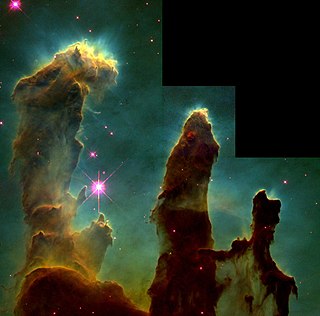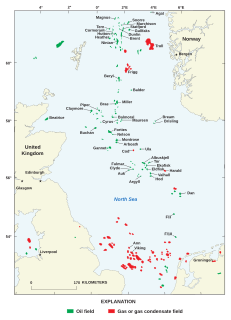
The giant planets constitute a diverse type of planet much larger than Earth. They are usually primarily composed of low-boiling-point materials (volatiles), rather than rock or other solid matter, but massive solid planets can also exist. There are four known giant planets in the Solar System: Jupiter, Saturn, Uranus and Neptune. Many extrasolar giant planets have been identified orbiting other stars.

A nebula is a distinct body of interstellar clouds.

A terrestrial planet, telluric planet, or rocky planet, is a planet that is composed primarily of silicate rocks or metals. Within the Solar System, the terrestrial planets accepted by the IAU are the inner planets closest to the Sun, i.e. Mercury, Venus, Earth and Mars. Among astronomers who use the geophysical definition of a planet, two or three planetary-mass satellites – Earth's Moon, Io, and sometimes Europa – may also be considered terrestrial planets; and so may be the rocky protoplanet-asteroids Pallas and Vesta. The terms "terrestrial planet" and "telluric planet" are derived from Latin words for Earth, as these planets are, in terms of structure, Earth-like.

Presolar grains are interstellar solid matter in the form of tiny solid grains that originated at a time before the Sun was formed. Presolar stardust grains formed within outflowing and cooling gases from earlier presolar stars.

Chthonian planets are a hypothetical class of celestial objects resulting from the stripping away of a gas giant's hydrogen and helium atmosphere and outer layers, which is called hydrodynamic escape. Such atmospheric stripping is a likely result of proximity to a star. The remaining rocky or metallic core would resemble a terrestrial planet in many respects.

North Sea oil is a mixture of hydrocarbons, comprising liquid petroleum and natural gas, produced from petroleum reservoirs beneath the North Sea.

An ice giant is a giant planet composed mainly of elements heavier than hydrogen and helium, such as oxygen, carbon, nitrogen, and sulfur. There are two ice giants in the Solar System: Uranus and Neptune.

Gliese 876 d is an exoplanet approximately 15 light-years away in the constellation of Aquarius. The planet was the third planet discovered orbiting the red dwarf Gliese 876. It was the lowest-mass extrasolar planet apart from the pulsar planets orbiting PSR B1257+12 at the time of its discovery. Due to this low mass, it can be categorized as a super-Earth.

A super-Earth is an extrasolar planet with a mass higher than Earth's, but substantially below those of the Solar System's ice giants, Uranus and Neptune, which are 14.5 and 17 times Earth's, respectively. The term "super-Earth" refers only to the mass of the planet, and so does not imply anything about the surface conditions or habitability. The alternative term "gas dwarfs" may be more accurate for those at the higher end of the mass scale, although "mini-Neptunes" is a more common term.
HD 5319 b is a gas giant exoplanet discovered in 2007 in the constellation of Cetus. This planet has a minimum mass nearly two times that of Jupiter. The planet has an almost circular orbit, with an eccentricity of only 0.02 and a period of 641 days. An additional planet in the system was discovered in 2015 and may be in a 4:3 mean motion resonance with planet b.

A hot Neptune or Hoptune is a type of giant planet with a mass similar to that of Uranus or Neptune orbiting close to its star, normally within less than 1 AU. The first hot Neptune to be discovered with certainty was Gliese 436 b in 2007, an exoplanet about 33 light years away. Recent observations have revealed a larger potential population of hot Neptunes in the Milky Way than was previously thought. Hot Neptunes may have formed either in situ or ex situ.
Gliese 676 is a 10th-magnitude wide binary system of red dwarfs that has an estimated minimum separation of 800 AU with an orbital period of greater than 20,000 years. It is located approximately 54 light years away in the constellation Ara. In 2009, a gas giant was found in orbit around the primary star, in addition to its confirmation in 2011 there was also a strong indication of a companion; the second gas giant was characterised in 2012, along with two much smaller planets.

An exoplanet is a planet located outside the Solar System. The first evidence of an exoplanet was noted as early as 1917, but was not recognized as such until 2016; no planet discovery has yet come from that evidence. What turned out to be the first detection of an exoplanet was published among a list of possible candidates in 1988, though not confirmed until 2003. The first confirmed detection came in 1992, with the discovery of terrestrial-mass planets orbiting the pulsar PSR B1257+12. The first confirmation of an exoplanet orbiting a main-sequence star was made in 1995, when a giant planet was found in a four-day orbit around the nearby star 51 Pegasi. Some exoplanets have been imaged directly by telescopes, but the vast majority have been detected through indirect methods, such as the transit method and the radial-velocity method. As of 1 July 2022, there are 5,108 confirmed exoplanets in 3,779 planetary systems, with 826 systems having more than one planet. This is a list of the most notable discoveries.

PSO J318.5−22 is a rogue planet, an extrasolar object of planetary mass that does not orbit a parent star. It is approximately 80 light-years away and belongs to the Beta Pictoris moving group. The object was discovered in 2013 in images taken by the Pan-STARRS PS1 wide-field telescope. PSO J318.5-22's age is inferred to be 12 million years, the same age as the Beta Pictoris group. Based on its calculated temperature and age, it is classified under the brown dwarf spectral type L7.

A gas giant is a giant planet composed mainly of hydrogen and helium. Gas giants are also called failed stars because they contain the same basic elements as a star. Jupiter and Saturn are the gas giants of the Solar System. The term “gas giant” was originally synonymous with “giant planet”, but in the 1990s it became known that Uranus and Neptune are really a distinct class of giant planets, being composed mainly of heavier volatile substances. For this reason, Uranus and Neptune are now often classified in the separate category of ice giants.
HD 155233 b is a confirmed exoplanet orbiting around the K Giant star HD 155233 every 885 days some 244.94 light-years away. It has a mass of 636 Earth masses or 2 Jupiter masses and is likely a gas giant similar of that to Jupiter just double the mass. It was discovered by Wittenmyer et al. on October 22nd 2015.
WASP-47 is a star similar in size and brightness to the Sun about 870 light-years away in the constellation Aquarius. It lies within the Kepler K2 campaign field 3. It was first noticed to have a hot Jupiter exoplanet orbiting every 4 days in 2012 by the Wide Angle Search for Planets (WASP) team. While it was thought to be a typical hot Jupiter system, three more planets were found in 2015: an outer gas giant within the habitable zone, a hot Neptune exterior to the hot Jupiter's orbit and a super-Earth interior to the hot Jupiter's orbit. WASP-47 is the only planetary system known to have both planets near the hot Jupiter and another planet much further out.

The Radcliffe wave is the nearest coherent gaseous structure in the Milky Way, dotted with a related high concentration of interconnected stellar nurseries. It stretches about 8,800 light years. It runs with the trajectory of the Milky Way arms, and lies at its closest at around 400 light-years and at its farthest about 5000 light-years from the Sun, always within the Local Arm itself, spanning about 40% of its length and on average 20% of its width. Its discovery was announced in January 2020 and its proximity surprised astronomers.

TYC 8998-760-1 is a young star, about 17 Ma old, located 310 light years away in the constellation of Musca, with a mass 1.00±0.02 times the Sun.

COCONUTS-2 b, or WISEPA J075108.79-763449.6, is a gas giant exoplanet that orbits the M-type star L 34-26. With a mass of 6.3 Jupiters, it takes over one million years to complete one orbit around the star, and it is 6000 AU away from it.















